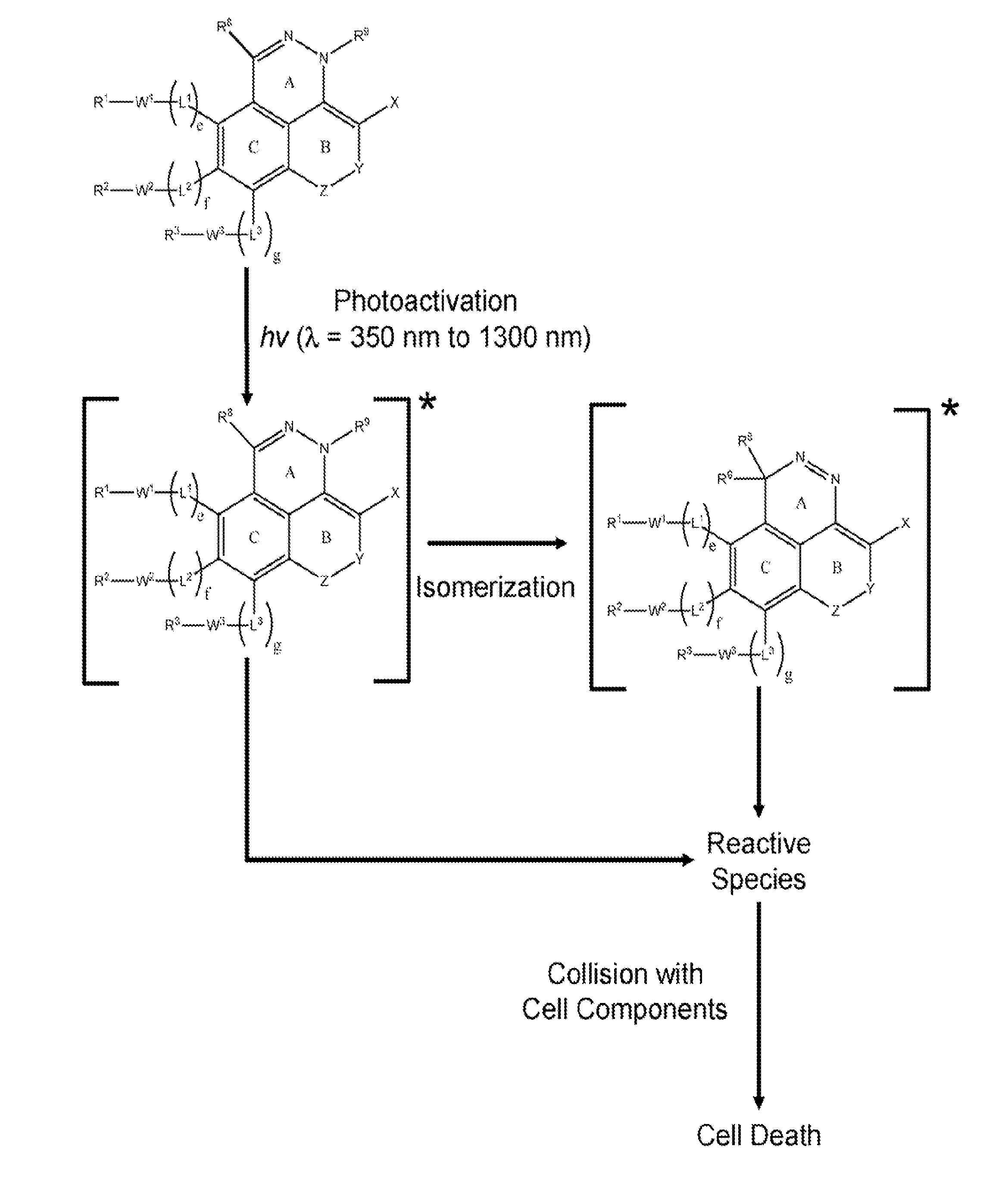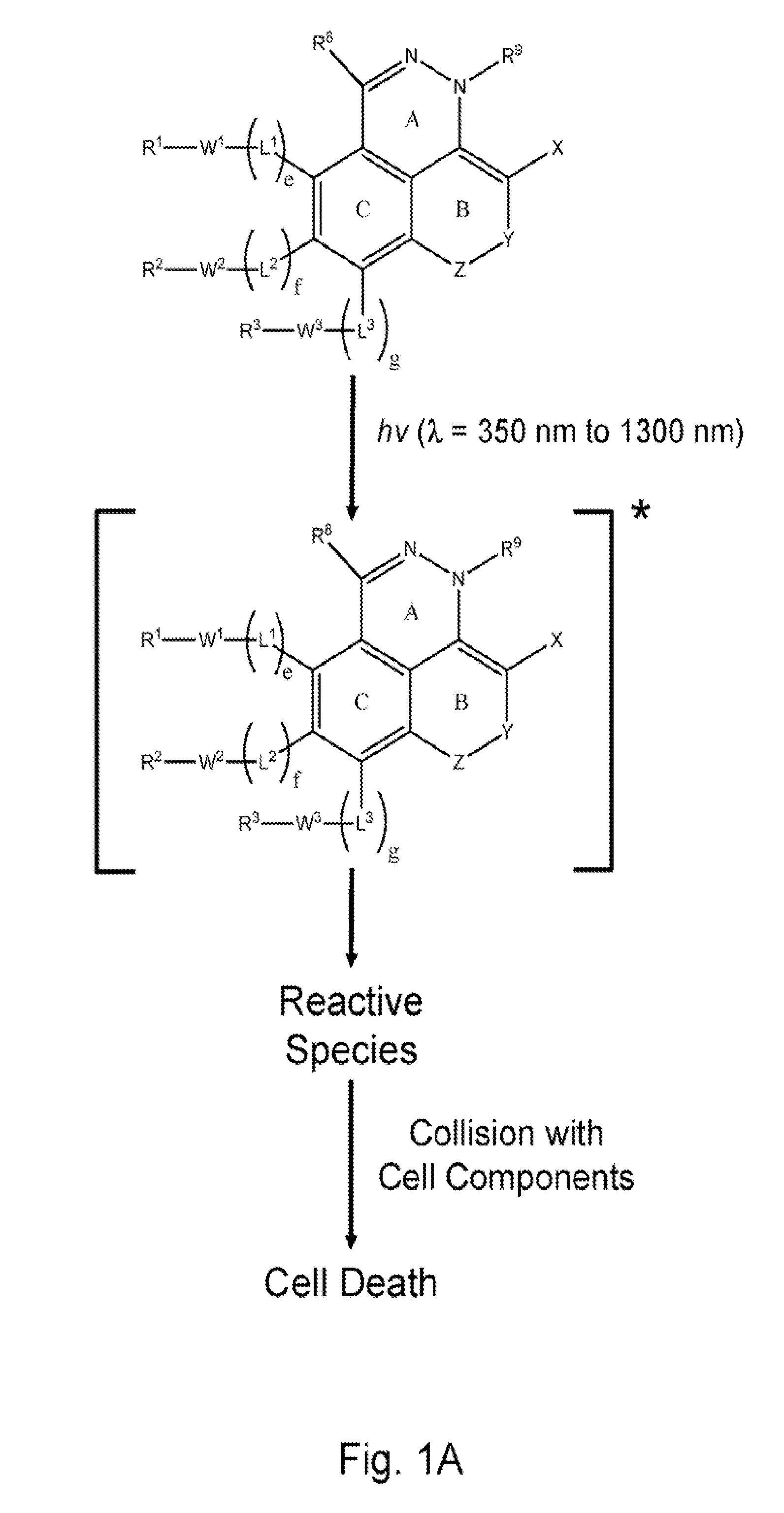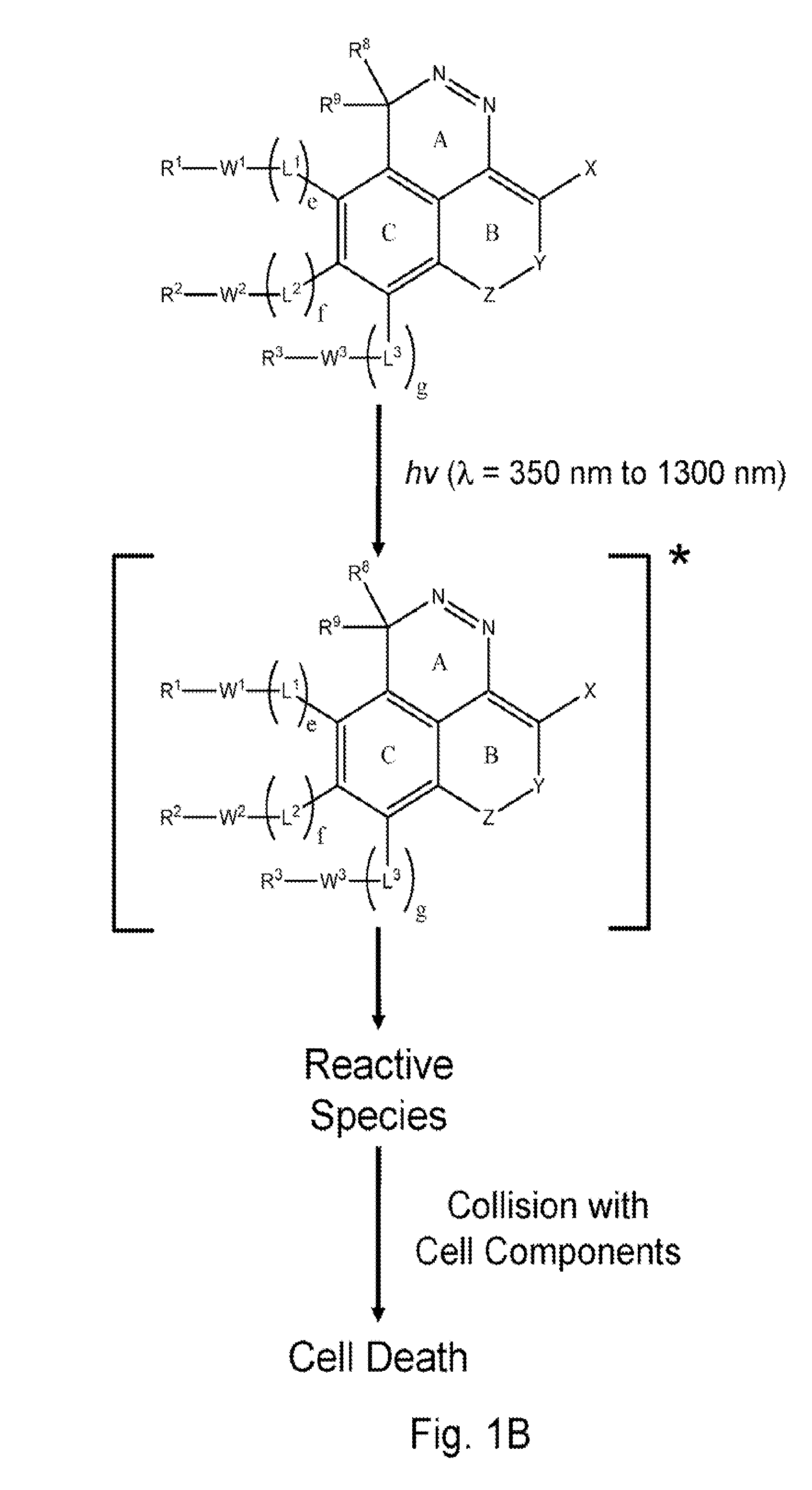[0002]Optical agents currently play a central role in a large number of
in vivo,
in vitro and
ex vivo clinical procedures including important diagnostic and therapeutic procedures. Photodiagnostic and phototherapeutic agents, for example, include a class of molecules capable of absorbing, emitting, or scattering
electromagnetic radiation applied to a biological material, particularly in the visible and near
infrared regions of the
electromagnetic spectrum. This property of optical agents is used in a range of biomedical applications for visualizing, imaging or otherwise characterizing
biological materials and / or achieving a desired therapeutic outcome. Recent developments in targeted administration and delivery of optical agents, and advanced systems and methods for applying and detecting electromagnetic
radiation in biological environments has considerably expanded the applicability and effectiveness of optical agents for clinical applications.
[0010]Much of the research in the past several decades has focused on developing phototherapeutic agents based on the Type 2 (PDT) mechanism. Surprisingly, there has been considerably less attention devoted to Type 1 phototherapeutic agents despite the fact that there are numerous classes of compounds that could potentially be useful for phototherapy that function via this mechanism. Unlike Type 2, the Type 1 process does not require
oxygen; and hence Type 1 photosensitizers are expected to be potentially more effective than Type 2 photosensitizers under hypoxic environments typically found in
solid tumors. Second, the Type 1 mechanism involves two steps (
photoexcitation and direct
energy transfer), whereas the Type 2 mechanism involves three steps (
photoexcitation,
singlet oxygen generation, and
energy transfer). Further, studies have recently shown that production of high levels of
reactive oxygen species can induce an anti-
inflammatory response, which may result in blood vessels to become more “leaky,” thereby increasing the risk of
metastasis (Chen, B.; Pogue, B.; Luna, J. M.; Hardman, R. L.; Hoopes, P. J.; Hasan, T. Tumor vascular permeabilization by vascular-targeting photosensitization: effects, mechanism, and therapeutic implications. Clinical
Cancer Research 2006, 12(3, Pt. 1), 917-923). Targeted Type 1 photosensitizers, by their very nature, are not expected to produce
reactive oxygen species; rather, the reactive species produced by these photosensitizers will immediately react with the
cellular component at the
binding site and trigger
cell death. Type 2 phototherapeutic agents, however, do have certain advantages over Type 1 agents. For example, Type 2 agents can potentially be catalytic, i.e., the Type 2
photosensitizer is regenerated once the
energy transfer to the
oxygen has taken place. In contrast, Type 1 process would generally be expected to require stoichiometric amounts of the
photosensitizer in some
clinical settings. Table I provides a summary of the attributes of Type 1 and Type 2 phototherapeutic agents. Given these attributes, it is clear that development of safe and effective Type 1 phototherapeutic agents would be useful to complement the existing therapeutic approaches provided by Type 2 agents, and to enhance the therapeutic portfolio available for clinicians.TABLE 1Comparison between Type 1 and Type2 processes for phototherapy.TYPE 1 PROCESSTYPE 2 PROCESSTwo-step process.Three-step process.Not well explored.Very well studied.
Electromagnetic radiation of anyRequires red electromagneticwavelength can be used.
radiation for optimal performance.Does not require
oxygen.Requires oxygen.Large classes of compounds.Limited classes of compounds.Stoichiometric.Potentially catalytic.Intramolecular energy transfer toIntermolecular energy transfer togenerate reactive species.generate reactive oxygen species.No products in the market.Two products are in use.
[0011]Specific optical, chemical and pharmacokinetic properties of optical agents are necessary for their effective use in Type 1 and Type 2 phototherapeutic applications. For example, optical agents for these applications preferably have strong absorption in the visible or NIR regions, and also exhibit low
systemic toxicity, low mutagenicity, and rapid clearance from the
blood stream. These optical agents must also be compatible with effective administration and delivery to the
target tissue, for example by having reasonable solubilities and a low tendency for aggregation in solution. Upon excitation by absorption of visible and NIR electromagnetic
radiation, optical agents for Type 1 and 2 phototherapy preferably provide large yields of
singlet oxygen (Type 2) or other reactive species, such as free radicals or ions, capable of causing local
tissue damage. Both Type 1 and Type 2 photosensitizers typically undergo photoactivation followed by
intersystem crossing to their lowest triplet
excited state, and therefore, a relatively long triplet lifetime is usually beneficial for providing effective
tissue damage. Other useful properties of optical agents for these applications include chemical inertness and stability, insensitivity of optical properties to changes in pH, and compatibility with conjugation to ligands providing targeted delivery via
molecular recognition functionality. Multifunctional optical agents have also been developed for phototherapy that are capable of providing both imaging and visual functionality upon excitation at a first range of wavelengths and phototherapeutic functionality upon excitation at a second range of
wavelength. (See, U.S. Pat. No. 7,235,685 and International Patent Publication WO 2007 / 106436).
[0012]Optical agents for some phototherapeutic applications preferably exhibit a high degree of selectivity for the
target tissue. Selectivity provided by optical agents facilitates effective delivery to a
target tissue of interest and provides a means of differentiating different tissue classes during therapy. Selective tissue injury can be induced with electromagnetic radiation when photosensitizers bind to the target tissues either directly, as in the case of Photofrin, or through attachment to a bioactive carrier, or through in situ biochemical synthesis of the
photosensitizer in localized area, as in the case of 2-aminolevulinic acid, which is an intermediate in the
biosynthesis of
porphyrin. Previous studies have shown that certain dyes selectively localize in tumors and serve as a powerful probe for the detection and treatment of small cancers. (D. A. Belinier et al., Murine
pharmacokinetics and antitumor
efficacy of the photodynamic sensitizer 2-[1-hexyloxyethyl]-2-devinyl pyropheophorbide-a, J. Photochem. Photobiol., 1993, 20, pp. 55-61; G. A. Wagnieres et al.,
In vivo fluorescence spectroscopy and imaging for oncological applications, Photochem, Photobiol., 1998, 68, pp. 603-632; J. S. Reynolds et al., Imaging of spontaneous canine mammary tumors using fluorescent contrast agents, Photochem. Photobiol., 1999, 70, pp. 87-94). It is recognized in some situations, however, that many dyes do not localize preferentially in malignant tissues. A number of strategies have been developed for imparting selectivity and / or targeting functionality by incorporation of a
molecular recognition component in the optical agent. For example, targeting of fluorescent dyes to tumors has been demonstrated using dye conjugates with antibodies and peptides for diagnostic imaging of tumors. (See, Achilefu et al., Novel
receptor-targeted fluorescent contrast agents for in vivo imaging of tumors, Investigative
Radiology, 2000, 35, pp. 479-485; Ballou et al., Tumor labeling in vivo using
cyanine conjugated
monoclonal antibodies,
Cancer Immunology and
Immunotherapy, 1995, 41, pp. 257-263; and Licha et al., New contrast agent for
optical imaging: acid cleavable conjugates of
cyanine dyes with biomolecules, in Biomedical Imaging: Reporters, Dyes and
Instrumentation, Proceedings of SPIE, 1999, 3600, pp. 29-35). Therefore,
receptor-target mediated phototherapy agents provide a promising pathway for achieving
site selective activation at various target tissues.
[0048]Fused ring azo and diaza compounds of the invention include unsaturated ring B fused to ring A which has an intra-ring azo or intra-ring diaza group and is fused to aromatic ring C. In an embodiment, unsaturated ring B has an intra-ring
alkene group, wherein a
carbon atom of the
alkene group is also a ring member of ring A. In some embodiments, the presence of the intra-ring
alkene group may enhance the stability of the fused ring azo or diaza compound prior to photoactivation, for example, under formulation, delivery and in vivo conditions. In some embodiments, unsaturated ring B is provided in a configuration so as to extend the overall conjugation in the compound, for example extending the conjugation of aromatic ring C. Extending conjugation via incorporation of unsaturated ring B has the benefit in some compounds of enabling the photoactivation and
internal energy transfer processes to occur upon absorption of electromagnetic radiation having longer wavelengths, as compared to the unconjugated analog (e.g., an analog having saturated ring substituted for ring B), that results in generation of reactive species. Some compounds of the present invention, for example, have a red shifted absorption spectrum relative to corresponding compounds wherein ring B is substituted with a fully saturated 6 membered ring. Incorporation of unsaturated ring B in compounds of the invention is important for enabling phototherapy biomedical procedures using visible and NIR electromagnetic radiation, as opposed to
ultraviolet electromagnetic radiation that can cause unwanted
tissue damage upon application of electromagnetic radiation to a subject. Incorporation of unsaturated ring B in compounds of the invention is also significant as it allows use of visible and NIR electromagnetic radiation in a phototherapy procedure that is transmitted appreciably into
biological media. In some embodiments, the invention provides fused ring azo and diaza compounds having any of formula (FX1)-(FX29) wherein X is
hydrogen. In some embodiments, the invention provides fused ring azo and diaza compounds having any of formula (FX1)-(FX29), wherein X is a
halogen atom, such as F, Cl, Br, or At. Compounds of the invention having formula (FX1)-(FX29), wherein X is a
halogen atom, may be useful for generating reactive species comprising
halogen radicals upon photoactivation.
[0063]In some embodiments, compounds of the invention may optionally include a poly(
ethylene glycol) (abbreviated as PEG) component. In an embodiment, for example, the invention provides a composition having any one of the formula (FX1)-(FX29), wherein at least one of R1-R9 is —(CH2CH2O)bR51 and / or at least one of L1-L7 is —(CH2OCH2)b—, wherein b is selected from the range of 1 to 100. Incorporation of a poly(
ethylene glycol) glycol component in some compositions of the invention provides pharmacokinetic, chemical, and / or physical properties useful for bioanalytical, diagnostic and / or phototherapeutic applications. Poly(
ethylene glycol) containing compounds of some embodiments of the invention, for example, provide enhanced
biocompatibility,
low toxicity and suppress immune responses upon administration. Poly(
ethylene glycol) containing compounds of some embodiments of the invention facilitate formulation, administration and / or delivery, for example, by enhancing
solubility.
 Login to View More
Login to View More 


